|
|
 |
|
Cyclopoida ( Order ) |
|
|
|
Corycaeidae ( Family ) |
|
|
|
Corycaeus ( Genus ) |
|
|
|
Onychocorycaeus ( Sub-Genus ) |
|
|
| |
Corycaeus (Onychocorycaeus) ovalis Claus, 1863 (F,M) | |
| | | | | | | Syn.: | Corycäus obtusus : Giesbrecht, 1981; 1892 (part., p.659, 673, Pl.49, fig.29, Pl.51, figs.13-14); ? Farran, 1911 a (p.291, figs.F, Rem);
? Corycaeus latissimus Brady, 1914 (p.6, figs.F).
Corycaeus ovalis-lattus : Isari & al., 2006 (p.249: tab.II); Isari & al., 2011 (p.51, Table 2, abundance vs distribution);
Corycaeus ovalis : Corral Estrada & Pereiro Muñoz, 1974 (tab.I); Avancini & al., 2006 (p.149, Pl. 117, figs.F,M, Rem.);
Onychocorycaeus ovalis: Gaudy, 1963 (p.33, Rem.); Boxshall & Halsey, 2004 (p.494); Valdés & al., 2007 (p.104: tab.1); McKinnon & al., 2008 (p.844: Tab.1); Vidjak & Bojanic, 2009 (p.434, Table II, IV, V); Vives & Shmeleva, 2010 (p.238, figs.F,M, Rem.); Belmonte & al., 2013 (p.222, Table 2, abundance vs stations); in CalCOFI regional list (MDO, Nov. 2013; M. Ohman, comm. pers.); Jagadeesan & al., 2013 (p.27, Table 3, seasonal abundance); Zakaria & al., 2016 (p.1, Table 1); El Arraj & al., 2017 (p.272, table 2 (as Onchocorycaeus)); | | | | Ref.: | | | Claus, 1863 (p.158); F. Dahl, 1894 (p.72); Thompson, 1900 c (p.289, Rem.); Thompson & Scott, 1903 (p.240, 286); Wolfenden, 1911 (p.359); M. Dahl, 1912 (p.96, figs.F,M); Pesta, 1912 a (p.59, fig.M); 1913 (p.34); Farran, 1929 (p.211, 296); Rose, 1929 (p.69, Rem.); Wilson, 1932 a (p.359, figs.F,M); Rose, 1933 a (p.331, figs.F,M); Mori, 1937 (1964) (p.136, figs.F,M); Carvalho, 1952 a (p.169, figs.M); Krishnaswamy, 1953 (p.71, Rem.); Chiba & al., 1957 (p.312); 1957 a (p.12); Vilela, 1968 (p.40, fig.F); Corral Estrada, 1970 (p.244); Marques, 1973 (p.250, fig.F); Razouls, 1972 (p.96, Annexe: p.129, figs.F,M); 1974 c (1975) (p.91, figs.F,M); Marques, 1975 (p.53); Björnberg & al., 1981 (p.676, figs.F,M); Marques, 1982 (p.776); Lakkis & Zeidane, 1987 (p.20, figs.F,M, Rem.); Kim & al., 1993 (p.271); Boxshall, 1998 (p.225); Bradford-Grieve & al., 1999 (p.888, 975, figs.F,M); Conway & al., 2003 (p.257, figs.F,M, Rem.); |  issued from : C. Razouls in Vie Milieu, 1974, 24 (1.A). [p.108, Fig.10]. Female (from W medit.: Banyuls, France); A, urosome (dorsal); B, A2; C, P4.
|
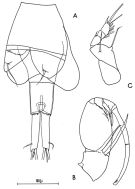 issued from : C. Razouls in Vie Milieu, 1974, 24 (1.A). [p.109, Fig.11]. Male: A, urosome (dorsal); B, A2; C, P4.
|
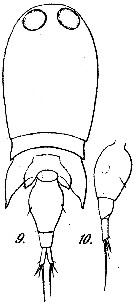 issued from : M. Dahl in Ergebnisse der Plankton-Expedition der Humboldt-Stiftung. Bd II, G. f1. I. Die Corycaeinen 1912. [Taf.XIII, Fig.9, 10]. Female: 9, habitus (dorsal); 10, urosome (lateral right side).
|
 issued from : M. Dahl in Ergebnisse der Plankton-Expedition der Humboldt-Stiftung. Bd II, G. f1. I. Die Corycaeinen 1912. [Taf.XIII, Fig.14]. Female: 14, A2.
|
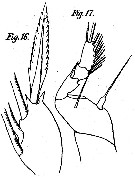 issued from : M. Dahl in Ergebnisse der Plankton-Expedition der Humboldt-Stiftung. Bd II, G. f1. I. Die Corycaeinen 1912. [Taf.XIII, Figs.16, 17]. Female: 16, endopod of P2; 17, P4.
|
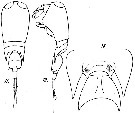 issued from : M. Dahl in Ergebnisse der Plankton-Expedition der Humboldt-Stiftung. Bd II, G. f1. I. Die Corycaeinen 1912. [Taf.XIII, Figs.11, 12, 13]. Male: 11, habitus (dorsal); 12, idem (lateral left side); 13, thoracic segments 3 and 4.
|
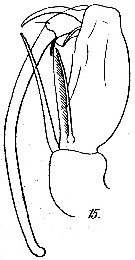 issued from : M. Dahl in Ergebnisse der Plankton-Expedition der Humboldt-Stiftung. Bd II, G. f1. I. Die Corycaeinen 1912. [Taf.XIII, Fig.15]. Male: 15, A2.
|
 issued from : G.P. Farran in Proc. zool. Soc. Lond., 1911. [Plate XII, Figs.8-9]. As Corycaeus obtusus. With doubt. Female (from Christmas Island, Indian): 4, P4; 5, 3rd and 4th thoracic segments (mounted); 6, A2. Nota: For Farran: the distinguishing characters are beyond the size (1.05-1.1 mm), the wide spreadind 3rd thoracic segments, the blunt tips to the 4th thoracic segments, the fine setae in front of the genital openings, the anal segment as long as it is broad at the base and nearly as long as the caudal rami, and the single seta on the endopodite of P4.
|
 issued from : T. Mori in The Pelagic copepoda from the neighbouring waters of Japan, 1937 (1964). [Pl.74, Figs.11, 14, 16]. . Female: 11, habitus (dorsal); 14, A2; 16, P4.
|
 issued from : T. Mori in The Pelagic copepoda from the neighbouring waters of Japan, 1937 (1964). [Pl.74, Figs.12, 13, 15, 17]. Male: 12, habitus (dorsal); 13, A2; 15, abdomen (ventral); 17, P4.
|
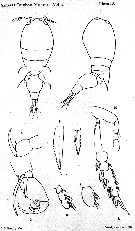 Issued from : G.S. Brady in Ann. Durban Mus., 1914, Vol. I. [Pl. I, figs. 6-9]. As Corycaeus latissimus ? Female (from Durban Bay, Natal): 1, habitus (dorsal); 2, same (lateral); 3, A2; 4, Md; 5, outer branch of P2; 6, terminal spine, outer branch of P2; 7, terminal spine, inner btanch of P2: 8, inner branch of P3; 9, terminal segment of inner branch of P3; 10, P5. Nota female: - Anterior division of the bpdy ovate, greatest width in front of the middle and equal yo more than half its length, broadly rounded in front, narrow and constricted behind, the 3rd segment produced laterally into very conspicuous wings, which are broad at the base and projected backwards, ending in long acuminate points. - Urosome 2-segmented, 1st segment nearly twice as long as the following one and excessively tumid. - Caudal rami equal in length to the last abdominal segment; 3 terminal setae, short. - eyes remote. - Apical spines of exopodites of P1 and P2 long and slender, outer edge very feebly pectinated; terminal spine of endopodite small, lancet-shaped and pectinated. - Endopod of P3 destitute of spines, the last segment ovate, its apex obliquely rounded off; its inner margin bearing 2 setae. - Endopodite of P4 consisting of a small papilla with 2 long setae. - P5 reduced to a single short seta on each side of the last thoracic segment. Remarks: The two species which most nearly approach this in general character are C. latus Dana, and C. obtusatus (= spp.) Giesbrecht, but neither of these appears to be at all so robust or tumid as the present species. Specimens referred, with some hesitation, to the latter of these two species were founded abundantly in Durban Bay, but are easily distinguished by their smaller size and by their beautifully opalescent blue tint, which appears to be dependant upon masses of dark blue pigment scattered about the tissues of the animal.
| | | | | Compl. Ref.: | | | Cleve, 1904 a (p.188); Carl, 1907 (p.18); Rose, 1925 (p.153); 1926 d (p.163); Massuti Alzamora, 1942 (p.106, Rem.); Wilson, 1942 a (p.182); 1950 (p.195); Fagetti, 1962 (p.53); Ganapati & Shanthakumari, 1962 (p.10, 16); Duran, 1963 (p.26); V.N. Greze, 1963 a (tabl.2); Mazza, 1966 (p.74); 1967 (p.367); Evans, 1968 (p.12); Salah, 1971 (p.320); Apostolopoulou, 1972 (p.329, 382); Vives & al., 1975 (p.58, tab.II,III, IV); Deevey & Brooks, 1977 (p.156, tab.2, Station "S"); Vives, 1982 (p.296); Kovalev & Shmeleva, 1982 (p.86); Scotto di Carlo & al., 1984 (p.1043); Regner, 1985 (p.11, Rem.:p.43); Jansa, 1985 (p.108, Tabl.I, II, III, IV, V); Brinton & al., 1986 (p.228, Table 1); Jimenez-Perez & Lara-Lara, 1988; Lozano Soldevilla & al., 1988 (p.61); Cervantes-Duarte & Hernandez-Trujillo, 1989 (tab.3); Suarez-Morales & Gasca, 1997 (p.1525); Sharaf & Al-Ghais, 1997 (tab.1); Hure & Krsinic, 1998 (p.94, 105); Suarez-Morales & Gasca, 1998 a (p.112); Siokou-Frangou, 1999 (p.479); El-Serehy, 1999 (p.172, Table 1, occurrence); Lavaniegos & Gonzalez-Navarro, 1999 (p.239, Appx.1); Neumann-Leitao & al., 1999 (p.153, tab.2); Suarez-Morales & al., 2000 (p.751, tab.1); Seridji & Hafferssas, 2000 (tab.1); d'Elbée, 2001 (tabl. 1); Zerouali & Melhaoui, 2002 (p.91, Tableau I); Vukanic, 2003 (p.139, tab.1); Khelifi-Touhami & al., 2007 (p.327, Table 1); Morales-Ramirez & Suarez-Morales, 2008 (p.524); Hafferssas & Seridji, 2010 (p.353, Table 2); Hafferssas & al., 2010 (p.1281, Table III, abundance vs spatial distribution); Hernandez-Trujillo & al., 2010 (p.913, Table 2); Mazzocchi & Di Capua, 2010 (p.428); Maiphae & Sa-ardrit, 2011 (p.641, Table 2, 3, Rem.); Tutasi & al., 2011 (p.791, Table 2, abundance distribution vs La Niña event); Lidvanov & al., 2013 (p.290, Table 2, % composition); Rojas-Herrera & al., 2016 (p.40, Table 2: temporal abundance, Table 3: diversity index); Benedetti & al., 2016 (p.159, Table I, fig.1, functional characters); Ben Ltaief & al., 2017 (p.1, Table III, Summer relative abundance); Palomares-Garcia & al., 2018 (p.178, Table 1: occurrence); | | | | NZ: | 16 + 1 doubtful | | |
|
Distribution map of Corycaeus (Onychocorycaeus) ovalis by geographical zones
|
| | | | | | | | | | | | | Loc: | | | South Africa (E), St. Helena Is. (S & N), off Ascension Is., G. of Guinea, off NE St. Paul Is., Cape Verde Is., off Morocco-Mauritania, Canary Is., off Madeira, Brazil, off Natal, Caribbean Sea, Yucatan, off Bermuda (Station "S"), Sargasso Sea, Woods Hole, S Bay of Biscay, Portugal, Ibero-moroccan Bay, Medit. (Alboran Sea, Algiers, El Kala shelf, Castellon, Baleares, Banyuls, Marseille, Ligurian Sea, Napoli, Messina, G. of Gabes, Gulf of Taranto, Malta, Adriatic Sea, Ionian Sea, Aegean Sea, Thracian Sea, Egyptian coast), Red Sea, Arabian Gulf, UAE coast, Arabian Sea, Madagascar (Nosy Bé), Seychelles, Indian, India (G. of Mannar, Palk Bay, Lawson's Bay), G. of Thailand, Indonesia-Malaysia, Ambon Bay, Philippines, China Seas, S Korea, S Japan, off Washington, W & S Baja California (Bahia Magdalena, La Paz), Gulf of California, Mazatlan Bay, Acapulco Bay, W Mexico, W Costa Rica, W Panama, Galapagos-Ecuador, Fiji Is., Australia (North West Cape), off Chile, Bering Sea (in C.B. Wilson, 1950) | | | | N: | 119 | | | | Lg.: | | | (35) F: 1,02; (45) F: 1,65-1,6; M: 1,4-1,3; (91) F: ± 1,1; M: ± 0,8; (327) F: 1,12-0,97; M: 0,87; (332) F: 1,08-1,07; (531) F: 1; M: 0,85; (651) F: 1,18-1,12; (666) F: 1,01; M: 0,88; (670) F: 1,06-0,92; M: 0,85-0,82; (920) F: 1,62; (991) F: 1,6-1,65; M: 1,3-1,4; ? (1320) F: 1,05; {F: 0,92-1,65; M: 0,80-1,40} | | | | Rem.: | Overall Depth Range in Sargasso Sea: 0-500 m (Deevey & Brooks, 1977, Station "S");
See remarks of Sewell (1947, p.286) and Tanaka (1964 p.17) on Corycaeus pacificus.
For Boxshall & Halsey (2004, p.491) the subgenus (Dahl, 1912) is considered as full generic status pending phylogenetic revision of the whole family at the generic level.
See in DVP Conway & al., 2003 (version 1) | | | Last update : 21/10/2022 | |
|
|
 Any use of this site for a publication will be mentioned with the following reference : Any use of this site for a publication will be mentioned with the following reference :
Razouls C., Desreumaux N., Kouwenberg J. and de Bovée F., 2005-2025. - Biodiversity of Marine Planktonic Copepods (morphology, geographical distribution and biological data). Sorbonne University, CNRS. Available at http://copepodes.obs-banyuls.fr/en [Accessed December 04, 2025] © copyright 2005-2025 Sorbonne University, CNRS
|
|
 |
 |














